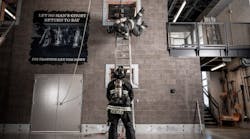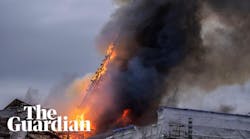As we have been reporting over the past two months, on Jan. 18, 2014, the Manhasset-Lakeville Fire Department (M-LFD) of Long Island, NY, was alerted to respond to a reported fire in a dwelling. What happened on that call teaches a lesson for all of us. Our sincere thanks to M-LFD Chief of Department Christopher Pisani and Deputy Chiefs Kirk Candan, Michael Farrone, Scott Garrigan and Mark Kiess for their assistance in sharing this report. Additional thanks to Lieutenant Sean Dolan, Firefighter John McCann, Lieutenant Lee Genser, EMT Tracey Dolan, Fire Commissioners Donald T. O’Brien, Andrew J. DeMartin and Brian J. Morris as well as all the members and mutual aid departments who responded to this incident.
The following account is by M-LFD Deputy Chief Mike Farrone:
I was the last chief officer to arrive on the scene. Chief Pisani was setting up the command post and Chiefs Candan and Keiss were already inside the fire building. The smoke condition outside was so light that I remember asking Chief Pisani which house was on fire.
I entered the first floor of the home to help coordinate companies operating and was met by light smoke and no heat. The smoke was so light I do not even go on my SCBA (self-contained breathing apparatus). Command ordered us to open windows, but not to do any unnecessary damage to the home to relieve the minor smoke condition. While members were opening a French door on the C side, I observed fire coming from a floor heat vent. I ordered, by radio, the second hoseline to extinguish this fire so it would not spread to curtains nearby.
While operating on the first floor, a primary search was conducted on both the first and second floors. These we both negative. Ex-Captain John McCann was conducting a search on the first floor in a bedroom and bathroom near the D side of the home. He alerted me that the floor in a closet had been burned through. The smoke and heat on the first floor had become worse and I donned my air mask.
Using a thermal imager from the doorway of the bedroom I was able to guide Ex-Captain McCann around the bedroom during his search. There were a few hot spots on the floor and he stated the floor was soft in some areas. He exited the room and we spoke about the fire traveling in the basement. He also noted the worsening fire conditions on the first floor. At this point, conditions were getting worse as we opened windows.
I had members open up an area of the wall near the garage on the B side and smoke was pushing from the openings we had just made. What we saw did not add up to the reports from the basement that they had extinguished the fire. Fortunately, Chief Candan had left the building to speak to command and when he reentered he observed that the first-floor entry area was now tilted. He made an urgent transmission to command of his finding and Chief Pisani ordered the house evacuated of all members. I left the dwelling last to make sure all members had left safely. All members were accounted for and a defensive operation was initiated.
This fire was a real eye opener; we could have lost almost 20 members who were operating inside the home. The members had to evacuate from the basement so quickly that they had to leave the first-due attack line in the basement. That is how fast conditions went bad. This all occurred within 10 minutes of my arrival. I am still amazed at how fast this fire went from a “nothing fire” to getting away from us and losing the entire house. Thankfully, all of our members are safe.
The following account is from M-LFD Lieutenant Sean Dolan:
Upon my arrival, there was “nothing showing” from the large, 2½-story, 5,000-plus-square-foot private dwelling. I met with Deputy Chief Kiess at the top of the basement stairs, where he reported something was on fire in the basement toward the front of the house. Kneeling at the top of the basement stairs, I donned my mask, preparing to enter the basement. Only a little smoke was venting out of the doorway to the basement, yet heavy smoke was pushing from around the doorframe to the basement, indicating we had a “structural fire” as opposed to a “contents fire” (important information at any fire, but even more so when you are dealing with wood-truss construction).
Upon receiving this information, Chief Pisani ordered the crew of Engine 8740 to stretch a 1¾-inch attack line to the front door. The crew advanced a 300-foot pre-connect to the front door and awaited further orders. The original hydrant secured to supply Engine 8740 was found to be defective. Another hydrant just passed the original hydrant was checked and found to be in good working order, so the crew worked on securing a water supply from this one. A message was transmitted to advise incoming units of the original hydrant issue and the remedy.
Deputy Chief Kiess and I entered the basement and made our way to the front of the house, where we found fire exposing from the ceiling. Conditions inside were nearing zero visibility, with little to no heat. I advised command we had a working fire. Using a water can, I knocked the fire back as much as possible. As a landmark of where the fire conditions first exposed, I left the can beneath the section of ceiling. Deputy Chief Kiess and I then made our way back to the top of the stairs.
At the top of the stairs, I advised the crew of Engine 8740 of the conditions and location of the fire we had found. Members on the first floor had reported some extension in the A/D (front right) corner of the dwelling in addition to the fire we had found. The crew of Engine 8740 and I then entered the basement while the crew of Engine 8735 stretched a second line to the first floor to address the conditions there. Once in the basement, the line was advanced to the front of the house to where the can I had originally used was, and fire conditions in the ceiling were extinguished. Additional members of Engine 8740 had brought hooks to the basement and opened up the ceiling in the area affected, and pockets of fire were knocked down. Conditions in the basement were not unreasonable. There was no visibility and moderate heat conditions. With the hoseline in place and water on the fire, I requested a vent of the basement.
There were limited options for ventilation. On the exposure 2 side there was a window and exterior door to the basement and on the exposure D side a window. Deputy Chief Candan advised the exposure 4-side window would be taken in an effort to vent the area we were working in. With all visible fire knocked down, I advised Manhasset command that the main body of fire was knocked down and that we still had heavy smoke and moderate heat.
I requested a thermal imager to the basement and a report from the members on the first floor on where they had fire extension so I could direct the nozzle team in that direction. While this was occurring, a large metal object fell on Lieutenant Daniel Gasperetti’s head had (we guessed it was a lighting fixture, possibly a fluorescent light). Two members of the crew of Engine 8740 lifted the object off of Lieutenant Gasperetti’s helmet so he could continue operating. Not long after this was removed, another object like the one that had fallen before fell and became stuck on my helmet. The same two members who had removed the similar object from Lieutenant Gasperetti’s head removed the object from mine. This was a warning of what was to soon follow.
Once given the thermal imager, we located small pockets of fire in the ceiling toward the A/D corner of the basement and we saw that the floor decking was of truss construction (Deputy Chief Farrone had given this information in a progress report shortly before). While extinguishing the pockets of fire, we determined the fire had made its way behind us and was making its way toward the interior stairs we had entered from.
Recognizing the signs of potential risk, I pulled the members in the basement doing truck work back and sent them to the top of the stairs, so I could back the hoseline to the bottom of the basement stairs and regroup (this proved to be valuable in that when the urgent was transmitted the number of members operating in the basement was less then what was originally down there). I advised command that I had fire behind my members operating in the basement and that we were backing out to the stairs in an effort to regroup and make a coordinated attack on the fire.
Lieutenant Gasperetti said he was having an issue with his SCBA and was going to make his way out of the dwelling once out of the basement to obtain a new one. While the members made their way back to the stairs, a number of them, including me, became entangled in wires and cable that had fallen from the ceiling. Working together, we untangled all the members and continued to the stairs. While enroute to the stairs, fire rolled over our heads and was knocked down by the nozzleman.
Upon reentering the dwelling, Lieutenant Gasperetti and Deputy Chief Candan noticed fire coming through the floor by the front door and the above-mentioned floor shift. An urgent message was transmitted by Deputy Chief Candan to pull members from the basement and that a hoseline was needed to the front door. I heard the transmission of the urgent message, and acknowledged it, although I believe it was stepped on by another fireground transmission. The house had a large footprint and making our way through obstacles (clothes racks, chairs, etc.) in the basement made it tough to get back to the stairs. These obstacles, along with the large distance to the stairs (which was less than our original point of operating in the basement) and ensuring all members were making their way out of the basement and were not caught up or entangled on anything, caused me to somewhat zone-out to the radio. For the time, the stress was on the situation occurring in the basement took full priority of my mind.
Deputy Chief Candan had placed a member at the bottom of the stairs as a “homing beacon,” or guide, which aided in members finding the stairs. The hoseline became entangled on the way out and in an effort to expedite the process of evacuating, we left the nozzle. Using the hoseline to follow our way out, as well as the verbal commands from the member at the bottom of the stairs, my nozzleman and I made it to the base of the stairs. Once at the bottom of the stairs, I was unable to confirm the whereabouts of my backup firefighter. A rapid search of the area surrounding the base of the stairs was done where he was last known to be, as well as verbal shout outs to ensure no other members were in the basement. With no response, negative results on the search and the member at the bottom of the stairs advising that numerous members had already exited the basement, my nozzle firefighter and I made our way up the stairs. Once at the front door to the house, I confirmed that my backup firefighter had made it out (he was on the stairs pulling the line back when we had determined we were going to leave the line and continued up ahead of us) and I exited the structure. All members from my crew were accounted for and a verbal face-to-face report was given to command. Shortly after, the first-floor foyer area collapsed into the basement, directly into where we had been operating.
The following account is from M-LFD Firefighter John McCann, an ex-captain and the senior firefighter from Company 1:
I arrived at the scene with Lieutenant Jon Lee and we walked up to the command post. Sizing-up the fire building, I got a good look at the D side, the entire front and from the command post we were able to get a good look at most of the B side. There was already a line stretched into the fire building, which did not look very involved. There was a light smoke condition showing from the front door to the house and the same light and lazy smoke coming from the attached garage, which was on the B side.
During our response and walk to the command post, Lieutenant Lee and I discussed the fact that we knew this building was lightweight wood construction. We remembered having many drill days at this development during its construction around the year 2000. Upon our arrival at the command post, I told Chief Pisani that we knew this entire development of large homes was of lightweight wood-truss construction. I asked Chief Pisani if there were any reports yet on what kind of fire he had. Was it in the structure or was it just the contents? He informed us that he had reports of fire in the basement and that they already had water on the fire. He asked us to enter the structure to gain a better hold on the magnitude of the fire and to report back to him. While walking up the driveway, the smoke condition was the same and it really appeared that the first-arriving units had this under control, if not completely knocked down already.
We entered the building and immediately came to the basement stairs. I took a quick look down and saw the entire stair and charged hoseline going down it. Visibility was not a major problem. I would still say it was a light smoke condition. We met Chief Farrone near the top of the stairs and he asked us to assist in checking for extension on the first floor. We made our way toward the D side of the house and came across a closed door. Upon opening the door, we were met by a medium to heavy smoke condition. The smoke was not very hot and I contributed its volume to being enclosed and directly over the fire. Lieutenant Lee scanned the room with a thermal imager without any outstanding heat signatures. I immediately began a primary search of the room and kept in voice communication with Lieutenant Lee.
Further into our search, toward the rear of this room, we came across a walk-in closet and a bathroom. Near the walk-in closet I felt a decent amount of heat while I was performing the search. After feeling the wall, I came across a forced-air heat register that was hot to the touch. Lieutenant Lee noticed a strong heat signature through his thermal imager around a hot tub that was in the bathroom. We opened up around the tub and heat register, but had no active fire. I contacted Lieutenant Dolan, who was in the basement, to ask if he had any fire in any type of ductwork in the basement.
After consulting with Lieutenant Lee and Chief Farrone, we agreed on getting a hoseline into the room we were searching to extinguish any fire that might be in the ductwork and to have standby while we opened up around the hot tub. We were making our way back to the foyer to lead the hoseline into the room we were in when suddenly the floor slowly sagged in and around a large partition wall near the room where we were previously searching. It wasn’t very dramatic; the floor sag seemed almost slow motion and without warning. By now, we had about a seven-inch gap between the finished floor and the base molding with a large amount of fire pushing its way through the newly created void. This made it certain to me that the first-floor truss loft was involved and we had a big problem.
I immediately met face to face with Chief Farrone and reiterated to him that now we knew the structure was involved and it was time to leave. Engine 8735 operated a hoseline into that floor sag void and moved everyone into a defensive position outside the building. While making our exit, the scene had drastically changed. The basement stairs were now blacked out with dark smoke that was forcefully pushing from the doorframes, base moldings and light switches and outlets.
Lieutenant Lee and I made our way to the front of the building where a roll call was being conducted. I met Chief Pisani in the driveway and let him know of the serious situation we had. He reinforced the URGENT message to evacuate the building. During this time, the second line was operating from this point flowing water into the void where the floor had separated from the partition wall. Within minutes, the first floor suffered a much greater collapse in the same area where we had witnessed the first collapse.
Next: Lessons learned and reinforced
William Goldfeder presents “ ‘THAT’ Working Fire: Is It Predictable?” and “Another House Fire, But This One, We’ll Never Forget” at Firehouse Expo 2014.






